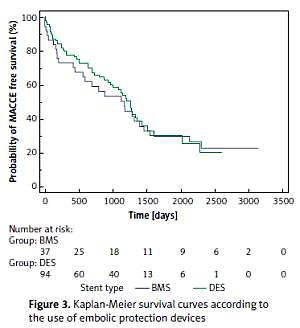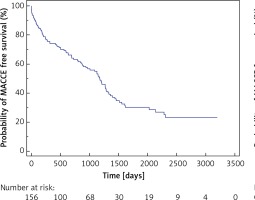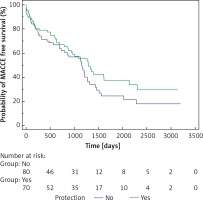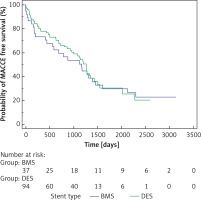Introduction
The long-term success of surgical coronary revascularization is limited, as at 1 year, the incidence of one or more total saphenous vein graft (SVG) occlusions after on-pump bypass surgery has been reported to be as high as 41% [1]. Due to the very high risk of cardiac surgery re-operations, percutaneous coronary intervention (PCI) is considered to be the preferred revascularization method of treatment in patients with SVG stenoses or occlusions [2]. However, PCI of SVGs remains technically challenging and is characterized by higher rates of periprocedural adverse events as compared to PCI of native coronary arteries [3]. Several typical complications of SVG interventions have been observed and investigated. One of the most common and influential consequences of SVG intervention on future outcomes is distal embolization. The incidence of distal embolization presented as the slow- or no-reflow phenomenon was estimated at 10% to 15% among patients with periprocedural angina and ischemic ST-segment changes [4]. Among the many factors, periprocedural complications were found to be associated with worse long-term outcomes in this group of patients [5]. Other well-studied factors likely to affect the outcomes of coronary artery bypass graft interventions include type of vessel, PCI, balloon and stent, anticoagulation in the periprocedural period and after PCI or the presence and type of anti-embolic protection devices against distal embolization. These predictors seem to be mostly preponderant. However, several other periprocedural indices related to technical aspects and maneuvers appear to be at least similarly influential for outcomes after coronary artery bypass graft interventions [6–10].
Therefore, we aimed to investigate the impact of the often overlooked and underrated factors associated with outcomes in patients undergoing PCIs within bypass grafts.
Material and methods
Retrospectively, we collected data on 194 consecutive patients undergoing PCI within coronary artery bypass grafts at our department from 2008 to 2016. At that time, about 1200–1400 PCI procedures were performed in our department every year. Follow-up data were collected from outpatients’ clinic documentation and by phone calls. The primary study endpoint included target-lesion revascularization (TLR), target-vessel revascularization (TVR), myocardial infarction (MI), cerebral stroke, coronary artery bypass grafting (CABG) and death.
Statistical analysis
Kaplan-Meier analysis was used for the primary endpoint assessment. Mantel-Cox and Breslow analyses were used for comparison between Kaplan-Meier curves. The data are expressed as means with standard deviations (SD), medians and interquartile ranges, and the percentage distribution, as appropriate. Both univariate and multivariate Cox proportional hazards models for study endpoints were constructed. Among the factors assessed in multivariate analysis, we included the number of bypasses treated with PCI, type of artery bridged by graft, bypass age, type of the lesion treated with PCI, thrombectomy, type of anti-embolic protection device and its use, presence of thrombus, location of the lesion in the graft (proximal, medial, distal), calcifications, type of stent, number of implanted stents, stent diameter and length, direct stenting, pre-dilatation, post-dilatation, maximal pressure of inflated balloon, residual stenosis > 10%, TIMI flow after the procedure, no-reflow phenomenon, PCI of the second vessel, treatment with glycoprotein IIb/IIIa inhibitor, and treatment with oral anticoagulants. Since the model could not achieve convergence for all the introduced predictors, following the relatively low number of events and data deficiencies concerning selected indices in the database, the analysis was limited to those potential predictors where there were fewer than eight missing results. This was done to increase test strength. For this reason, we excluded some factors with potentially less predictive impact for bypass restenosis including family history of cardiovascular events, the Global Registry of Acute Coronary Events (GRACE) score at admission, body mass index or Killip class stage. The log-rank test (Mantel-Cox) and Breslow test (generalized Wilcoxon) were used for comparison of major adverse cardiac and cerebrovascular event (MACCE) rates between particular types of PCI which included PCI with drug-eluting balloon (DEB), PCI with drug-eluting stent (DES) implantation, bare-metal stent (BMS) implantation and plain old balloon angioplasty (POBA) or failed PCI. Additionally, those tests were used for comparison of the MACCE rates between patients treated with distal protection devices and without them.
Results
The clinical characteristics of the overall group are presented in Table I. Data regarding the length of hospitalization were available for 175 (90.2%), of whom hospitalization time < 7 days was found in 93 (53.1%) patients, and ≥ 7 days in 82 (46.8%) patients. The causes of prolonged hospitalization should be mainly sought as a greater burden of risk factors for cardiovascular disease expressed as EuroSCORE II, which was statistically significantly higher in the group of patients hospitalized longer (13.2 ±14.3% vs. 11.1 ±15.1%, p = 0.02) and greater impairment of the left ventricular systolic function expressed as left ventricular ejection fraction (41.6 ±14.0% vs. 46.7 ±13.3%, p = 0.02). Additionally, patients with prolonged hospitalization were admitted to hospital insignificantly more often with myocardial infarction (42.6% vs. 34.8%, p = 0.28), kidney failure (32.1% vs. 19.8%, p = 0.11), Killip class II–IV (22.8% vs. 14.3%, p = 0.45) and heart failure expressed as New York Heart Association (NYHA) class III–IV (14.8% vs. 8.7%, p = 0.21). The clinical presentation of coronary artery disease and cardiovascular risk indices are presented in Table II. Pharmacological treatment at discharge from the hospital and periprocedural treatment with glycoprotein IIb/IIIa inhibitors are presented in Table III.
Table I
Clinical characteristics
Table II
Clinical presentation of coronary artery disease before percutaneous coronary intervention
Table III
Pharmacological therapy
Due to the fact that some of the patients included in the current study were sent to our center from tertiary catheterization laboratories, we did not repeat full coronary angiography, and primary recordings of coronary angiography were returned to the patient at discharge, which made it difficult to obtain data in the follow-up period. For this reason, complete coronary artery angiography performed before PCI was available in 182 individuals and it revealed single-vessel disease (SVD) in 1 (0.5%) patient, two-vessel disease in 14 (7.7%) patients and multi-vessel disease (MVD) in 167 (91.7%) patients. The radial access (RA) served for PCI in 10.8% of procedures. The target lesion treated with PCI was a de-novo lesion in 80.6% of patients, in-stent thrombosis in 2.1% of individuals and restenosis in 17.3% of patients. The internal mammary artery (IMA) was used as a graft in 37.1% of patients, one saphenous vein graft in 1.7%, two in 49.1% of patients, three in 34.6% and four venous grafts in 14.5% of patients. The PCI was performed in the saphenous graft to the left anterior descending (LAD) artery in 43.9% of patients, the circumflex (Cx) artery in 37.7%, the right coronary artery (RCA) in 23%, the left/right IMA in 4.7% and finally, the saphenous vein jump bypass graft in 4.7% of patients. Two or more bypasses were treated in 6.8% of patients while PCI of the second vessel (bypass or native artery) was done in 14.2% of patients. The culprit lesion was located in the proximal segment in 36.5% of cases, medial in 21.8%, distal in 23.5% and unknown location in 18.2% of individuals. Unknown location meant that in the available medical records considering the description of the PCI procedure, there was no information regarding which graft segment was treated with angioplasty. Among the thirteen patients in the POBA/failed PCI group, stent crossing/deployment was not obtained in eight patients with graft stenosis, of whom there were three patients with stable angina (SA) at admission, seven with non-ST-segment elevation myocardial infarction (NSTEMI) and one with unstable angina (UA). One patient with SA developed MI in the follow-up period, one patient with NSTEMI died, another had MI and another cerebral stroke. The remaining 4 patients did not have MACCE. Ineffective opening of the occluded graft caused by thrombus was found in 5 patients. Two of the patients had ST-segment elevation myocardial infarction (STEMI), one of whom died during the procedure, and another one did not present MACCE during the follow-up period. Of the remaining three patients, all had NSTEMI at admission, one of them had MI in the follow-up period, and the others did not develop MACCE during the follow-up. Other procedural indices are presented in Table IV.
Table IV
Procedural indices
The overall incidence of periprocedural complications was 29 (14.9%) out of 194 individuals. We noted 6 (3.1%) SVG dissections, 20 (10.5%) no-reflows, 1 (0.5%) perforation, 3 (1.6%) cardiac arrests, 2 (1%) acute left ventricle failures demanding intra-aortic balloon pump, 2 (1.1%) acute in-stent thromboses, 2 (1%) bleedings requiring blood transfusion, 2 (1%) respiratory insufficiencies requiring intubation and mechanical ventilation.
Long-term follow-up data were available for 156 (80.4%) patients and were limited to venous grafts, also in patients treated at baseline simultaneously with PCI of SVG and IMA or another native artery. The mean follow-up was 964 ±799.1 days (ranging from 0 to 3,200 days). The study endpoints were observed in 94 (59.7%) individuals from among all patients with completed follow-up. Among study endpoints, we noted 23 (24.2%) patients with TLR, 36 (37.9%) with TVR, 25 (26.3%) individuals with MI, 2 (2.1%) with CABG, 4 (4.2%) with cerebral stroke and 29 (30.5%) deaths. The mean time to the primary study endpoint was 669.6 ±598.7 days (from 0 to 2,307 days). The mean follow-up in patients without observed study endpoints (62 individuals) was 1,326.8 ±859.3 days (from 271 to 3,200 days). The Kaplan-Meier survival curve for all patients is presented in Figure 1.
The significant predictors of clinical endpoints for all variables entered, simultaneously assessed by Cox regression analysis, were in-stent thrombosis of previously implanted stent (hazard ratio (HR) = 6.97, 95% confidence interval (CI): 1.75–27.7, p < 0.01), anti-embolic protection (HR = 0.53, 95% CI: 0.29–0.96, p < 0.05), direct stenting (HR = 0.27, 95% CI: 0.07–0.96, p < 0.05), pre-dilatation (HR = 0.27, 95% CI: 0.08–0.84, p < 0.05), no-reflow (HR = 10.26, 95% CI: 2.82–37.26, p < 0.001), maximal pressure (HR = 1.023, 95% CI: 1.002–1.045, p < 0.05), and number of implanted stents per patient (HR = 0.36, 95% CI: 0.15–0.83, p < 0.05). Due to the fact that there are many non-significant variables that may interfere with the estimation of relevant predictors, it is difficult to interpret the results. Therefore, a model based on the retrograde correction method was constructed (where the predicate reject criterion) was the fact that its significance was above 0.10). The factors that significantly affected the incidence of endpoints were PCI of two or more bypasses (HR = 2.89, 95% CI: 1.37–6.00, p < 0.01), post-dilatation (HR = 1.76, 95% CI: 1.05–2.95, p < 0.05) and no-reflow (HR = 2.16, 95% CI: 1.06–4.43, p < 0.05) (Figure 2).
The results of the Mantel-Cox test comparing MACCE rates between particular types of PCI showed that PCI with DEB had significantly shorter survival times free of MACCE from PCI with DES implantation (p < 0.01), BMS implantation (p < 0.05) and POBA or failed PCI (p < 0.05) (Table V). The Breslow test (generalized Wilcoxon) results comparing MACCE rates between particular types of PCI revealed that PCI with DEB had significantly shorter survival times free of MACCE from patients treated with DES implantation (p < 0.05) and POBA or failed PCI (p < 0.05) (Table V). There was no significant difference in survival times free of MACCE between DES and BMS groups (p = 0.73) (Figure 3).
Table V
Indications and type of primary end-points according to type of PCI and protection status
[i] Data are expressed as mean ± SD and median with IQR or numbers (percentages). BMS – bare-metal stent, CABG – coronary artery bypass grafting, DEB – drug-eluting balloon, DES – drug-eluting stent, MACCE – main adverse cardiac and cardiovascular event, MI – myocardial infarction, PCI – percutaneous coronary intervention, POBA – plain old balloon angioplasty, TLR – target lesion revascularization, TVR – target vessel revascularization.
Due to the fact that MACCE occurred earlier in patients treated with DEB PCI when compared to non-DEB PCI, we compared the groups. In contrast to the non-DEB group, among the 8 patients included in this group, two of them presented SA at baseline, the other five UA and one patient NSTEMI. Seven patients were treated because of in-stent restenosis (87.5%) and one patient due to in-stent thrombosis. All patients in this group were diagnosed with MACCE during the follow-up period. Although the mean time to onset of the first MACCE was insignificantly shorter in patients in the DEB group compared to the non-DEB group (633.1 ±602.6 days vs. 673.0 ±605.4 days, p = 0.96), in the non-DEB group it was observed in 58.5% of patients for whom follow-up was completed compared to 100% in the DEB group. This was observed despite the fact that patients in the DEB group had lower cardiovascular risk (5.6 ±2.4% vs. 13.0 ±15.8%, p = 0.48) and statistically significantly shorter hospitalization time (3.6 ±1.2 days vs. 7.6 ±4.0 days, p < 0.01) when compared to the non-DEB group.
Results of the Mantel-Cox test and Breslow test comparing MACCE rates between PCI with and without anti-embolic protection were not significant in either estimation (p = 0.22 and p = 0.41) (Figure 3, Table V).
Discussion
In the present study, we demonstrated that PCI of two or more bypasses, post-dilatation and no-reflow are negative predictors of outcomes in patients undergoing PCI of coronary artery bypasses. The second finding worth mentioning is that patients treated with PCI with DEB had worse long-term outcomes as compared to PCI with DES, BMS, and even POBA and/or failed PCI. The third is that the anti-embolic protection did not improve outcomes during follow-up.
It was reported that periprocedural necrosis during SVG PCI is associated with increased mortality at 1 year [10]. Also a major CK-MB release after SVG intervention is a powerful independent predictor of late mortality. Moreover, lesion length, greater angiographic degeneration of SVGs, and larger estimated plaque volume were shown to be predictors of 30-day MACE after SVG intervention [11]. We did not confirm that the extent of myocardial necrosis is related to poorer outcomes in follow-up. However, we were not able to include continuous variables of troponin level in the analysis because of the different methods of testing used over the years. The univariate analysis of the association between continuous variables of myocardial creatine kinase (CK-MB) with study endpoints revealed no significance (p = 0.17). Also, dichotomous variables considering elevated markers of myocardial necrosis including troponin and CK-MB levels were not significantly associated with the study endpoints. We also did not find any relationships between gender and study endpoints in univariate analysis (p = 0.97). In contrast to our study, some authors have found that female gender and renal failure are also predictors of poorer clinical outcomes after PCI of SVG [12, 13]. The univariate analysis did not confirm a significant relationship between serum creatine level (p = 0.89), glomerular filtration rate assessed by the Cockcroft-Gault formula (p = 0.61) and dichotomous variables defining kidney failure as GFR < 60 ml/min (p = 0.95). Previously reported studies revealed that poorer clinical outcomes after initial SVG intervention most frequently resulted from disease progression at untreated non-significant stenosis [14]. The results of the VELETI trial suggested that moderate stenoses should be initially treated with DES implantation [15]. In the current study, we noted TLR in 39 patients, TVR in 46 patients and re-PCI in 59 patients. Based on this, we could conclude that 20 (33.8%) patients with TLR demanding re-PCI were not subjected to the procedure. We are not able to introduce lesions from patients demanding a CABG operation into that comparison, but there were only two individuals in this group. Also, the 32 cases of death noted during follow-up were mostly not preceded by coronary angiography or re-PCI, and only in two cases were they followed by TVR, and in one case, TLR. Despite the use of DES, the rate of TLR remains very high and it reaches above 60% within 18 months of follow-up in the group of patients with occluded SVG [16]. Unfortunately, the addition of antithrombotic medications such as glycoprotein IIb/IIIa inhibitors to filter embolic protection did not bring satisfactory results [17]. We also did not observe any effects of pre-procedural treatment with either oral coumarin derivatives or new oral anticoagulants (p = 0.91) and periprocedural treatment with glycoprotein IIb/IIIa inhibitors (p = 0.89) on study endpoints in univariate analysis. So far, the published studies have revealed significant differences in long-term outcomes between POBA and stents; however, the difference between the particular type of stents is not so clear. The SAVED trial proved the superiority of BMS implantation over POBA in terms of outcomes [18]. In our study, we revealed no statistically significant differences in clinical outcomes between PCI with DES and BMS implantation, and they were significantly better when compared to PCI with DEB. The results in the POBA/failed PCI group of patients should be treated with great caution, due to large deficiencies in the analysis and suspicion of bias in these findings. The other aspect is that in the SAVED report, the majority of SVG interventions were performed with stents. The other method of treatment is the use of covered stents. However, previously published studies did not confirm the superiority of covered stents over regular BMS implantation in SVG bypass stenoses [19]. Also, the RECOVERS trial did not confirm this relationship [20]. The use of mesh-guard stents in this group of patients is promising, as demonstrated in a recently published study [21]. The BARRICADE trial demonstrated that the TLR rate was even higher in patients treated with covered stents than those treated with BMS [22]. The superiority of DES stents over BMS was demonstrated in the RRISC trial during the 6-month follow-up and the SOS trial in 3-year follow-up [23]. However, other studies did not confirm those findings [24]. Other published meta-analyses confirmed the positive effects of DES stents on TLR, while there was no significant effect on mortality [25]. The effectiveness of PCI with DEB in patients with coronary bypasses is less investigated. Nonetheless, it was demonstrated that PCI with DEB brings better long-term outcomes when treating patients with BMS in-stent restenosis than DES in-stent restenosis [26]. Also, poorer outcomes were noted in patients with DEB PCI of SVG than the native arteries [26].
Despite the recommendation of international guidelines, the use of embolic protection devices is relatively rare. Previously published studies demonstrated that the use of embolic protection reached only 23% of patients undergoing PCI of SVG [27]. This could be explained by several disadvantages of those devices, including the need to cross the lesion before adequate protection, temporary cessation of blood flow, limiting visualization, inability to obtain full evacuation, and possible traumatic injury to the SVG during balloon occlusion [28]. Some trials did not reveal the superiority of embolic filters in comparison to the control group in terms of better clinical outcomes, and they were even associated with higher periprocedural complication rates in patients treated with filter embolic protection [29]. We also did not confirm the superiority of embolic protection filter devices used compared to the patients without protection. Additionally, similarly as in other studies, we did not find advantages of any embolic protection devices over the other ones [30].
Considering the results published so far and results of the current study, clinical outcomes in patients undergoing PCI of coronary artery bypasses depend on several periprocedural indices interacting with one another and leading to slow- or no-reflow. It seems that the differences between the particular stents and the use of anti-embolic protection devices are less relevant in this interaction compared to the procedure technique, which most influences the amount of debris released to the distal part of the vessel. The need for balloon post-dilatation after coronary stent deployment in native coronary arteries has been demonstrated in several studies [31], and in the case of SVG stenting, it becomes important due to the release of larger amounts of pro-embolic material, which increases the probability of slow-flow and no-reflow occurrence or strengthens it. In the present analysis, we did not find a relationship between graft age (which is indirectly associated with the amount of debris) and MACCE, as well as each of the individual components of MACCE separately. Previously published studies demonstrated that direct stenting was associated with lower periprocedural complication rates [32]. We also noted similar benefits of direct stenting in terms of long-term outcomes. However, it was only significant in the multivariate analysis model with simultaneous data assessment, and was not confirmed in a model based on the retrograde correction method. Hong et al. did not confirm a relationship between the ratio of the implanted stent diameter and the average intravascular ultrasound reference lumen diameter and clinical outcomes [33]. In the current study, we did not confirm a relationship between stent dimensions and clinical outcomes.
In conclusion, we demonstrated that PCI of two or more bypasses, post-dilatation and no-reflow are predictors of poorer clinical outcomes expressed as higher rates of TVR, TLR, MI, stroke, CABG, and deaths during long-term follow-up in patients undergoing PCI within bypasses. Also, PCI with DEB was associated with poorer outcomes in patients after bypass PCI during follow-up compared to PCI with stent implantation. However, the several limitations regarding this issue should be considered, and it would be advisable to carry out studies including much larger numbers of participants with the purpose of corroborating this relationship. The use of embolic protection filters has no statistically significant effect on clinical outcomes in patients treated with PCI of SVG during long-term follow-up.
The most critical limitation of the current study is the relatively low percentage of completed follow-ups and the lack of clinical data in some cases (80.6%). This was mostly caused by the participation of patients from small towns located in remote village areas or secluded areas, as well as changes in place of residence. The consequence of this may be misrepresentation of results, especially those regarding the comparison of treatment depending on the use of distal protection and the type of PCI. In the presented analysis, the percentage of patients with implanted LIMA grafts was only 37%, which is related to the period during which the material was collected (2008–2016), and in some sense includes the population of patients from the previous era. Nowadays, the proportion of patients with IMA grafts is much larger, which certainly has a significant impact on the results.






